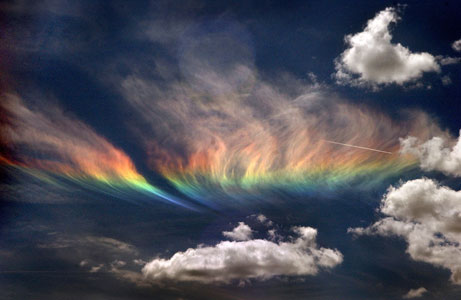This is a photo of Tibetan Buddhist monk, the Ven. K. C. Ayang Rinpoche, blessing the deer in Kyoto's Nara Park, July 26th, 1985. He only asked once for a photo of him to be taken, saying, "Take a photo now!" No one saw the rainbow until the print was developed. Rinpoche, on seeing the photograph, said he felt that his prayer blessing of the deer had been answered by the Buddha Amitabha at the very moment the photo was taken, when he had made contact with the deer, and that the power of His blessing appeared in rainbow form.

The so-called 'Sun Dog Painting' (Vädersolstavlan) depicting Stockholm in 1535 and the celestial phenomenon at the time interpreted as an ominous presage


A sun dog or sundog (scientific name parhelion, plural parhelia, for "beside the sun") is a common bright circular spot on a solar halo. It is an atmospheric optical phenomenon primarily associated with the reflection or refraction of sunlight by small ice crystals making up cirrus or cirrostratus clouds. Often, two sun dogs can be seen (one on each side of the sun) simultaneously.
https://en.wikipedia.org/wiki/Sun_dog
~~~~~~~~~~~~~~~~~~~~~~~~~~~~~~~~~~~~~~

June 19, 2006—It looks like a rainbow that's been set on fire, but this phenomenon is as cold as ice.
Known in the weather world as a circumhorizontal arc, this rare sight was caught on film on June 3 as it hung over northern Idaho near the Washington State border (map of Idaho).
The arc isn't a rainbow in the traditional sense—it is caused by light passing through wispy, high-altitude cirrus clouds. The sight occurs only when the sun is very high in the sky (more than 58° above the horizon). What's more, the hexagonal ice crystals that make up cirrus clouds must be shaped like thick plates with their faces parallel to the ground.
When light enters through a vertical side face of such an ice crystal and leaves from the bottom face, it refracts, or bends, in the same way that light passes through a prism. If a cirrus's crystals are aligned just right, the whole cloud lights up in a spectrum of colors.
This particular arc spanned several hundred square miles of sky and lasted for about an hour, according to the London Daily Mail.
—Victoria Gilman
https://news.nationalgeographic.com/news/2006/06/060619-rainbow-fire.html
~~~~~~~~~~~~~~~~~~~~~~~~~~~~~~~~~~~~~~~~~~~~~~~~~
When a rainbow formed in the sky people stopped and stared at the natural wonder. But then lightning sparked across the evening panorama as two of nature's most spectacular phenomenon created an unusual alliance. The clash of weather was seen above the affluent city of Fort Smith, in the Southern state Arkansas.O ne onlooker said, "It was awe inspiring. The lightning made a huge rumbling sound and when you looked up there was also this incredible rainbow forming on the horizon." The intracloud lightning, known as an anvil crawler, is the most common form of lightning, with the electrical charge contained within a single cumulonimbus cloud.

Lightning often occurs during heavy storms while rainbows are generally formed after the rain has stopped, making an appearance of both simultaneously relatively rare. The actual electric charge in a flash of lightning comes from particles from the sun sent out in the solar wind which gather in the outer atmospheric layers before creating a strike.
Scientists are still divided by what actually causes lightning, with one theory suggesting falling droplets of ice and rain become electrically polarized as they fall through the natural electric field in the Earth's atmosphere. This would explain why lightning often accompanies storms and heavy rain. The same droplets also cause the rainbow, when light from the sun is refracted by the water to cause a spectrum.
Lightning sharing the sky with a rainbow
Arkansas - Daily Mail - July 13, 2006
~~~~~~~~~~~~~~~~~~~~~~~~~~~~~~~~~~~~~~~~

Six Rainbows Across Norway
Explanation: Have you ever seen six rainbows at once? They are not only rare to see -- they are a puzzle to understand. The common rainbow is caused by sunlight internally reflected by the backs of falling raindrops, while also being refracted at the air / water boundary. To see a rainbow, look opposite the Sun towards a rainstorm. This primary rainbow is the brightest color swath in the above image. Multiple internal reflections inside water droplets sometimes make a secondary rainbow to become visible outside the first, with colors reversed. Just such a secondary rainbow is visible of the far left.
Harder to explain is the intermediate rainbow, between the two. This rainbow is likely caused by sunlight that has first reflected off the lake before striking the distant raindrops that is reflecting sunlight back toward the observer. Each of these rainbows appears to be reflected by the calm lake, although because the positions of rainbows depend on the location of the observer, a slightly displaced image of each rainbow is actually being imaged.
Credit & Copyright: Terje O. Nordvik
https://antwrp.gsfc.nasa.gov/apod/ap070912.html
Six Rainbows at Once Across Norway
NASA - September 11, 2007
A double rainbow features reversed colors in the outer (secondary) bow,with the dark Alexander's band between the bows.


